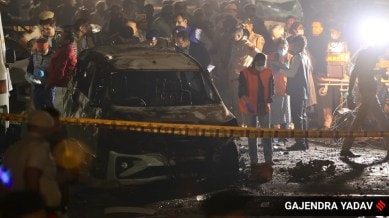Stay updated with the latest - Click here to follow us on Instagram
Red Fort blast exposes alarming gaps in purchase of used cars in NCR: Here are four things every buyer must know
There are roughly 5,000 small, medium, and large second-hand car dealers in the national capital.

The probe into the November 10 Red Fort blast has exposed major gaps in the second-hand vehicle market in Delhi and neighbouring districts.
Police traced the first owner through the unchanged RC, raising concerns about unregulated transactions and highlighting the need to streamline the rapidly expanding used-car market in the NCR.
The Indian Express spoke to several car dealers, transport authority officials, and transport expert Anil Chhikara to understand the process and why a grey area persists in the business.
How many such second-hand car dealers operate in Delhi? What licenses are required for this business?
There are roughly 5,000 small, medium, and large second-hand car dealers in the national capital. The sector remains completely unorganised because there are no checks and balances, and the government does not fully regulate them. As a result, dealers can buy or sell vehicles at any price they choose, depending on the condition.
The basic idea of second-hand car trading is to provide a common platform for vehicle sale and purchase. Traders earn a commission, similar to property dealers. However, buying or selling a vehicle without proper documentation is far riskier. If the vehicle is involved in an accident or mishap before ownership is officially transferred, sometimes days after the sale, the seller could face serious trouble.
What is the process of selling or purchasing a car through second-hand car dealers?
Two forms — Form 29 and Form 30 — must be filled out and submitted along with the buyer’s and seller’s details to the transport authority. Before 2022, this process was manual, but it is now digital. The buyer’s and seller’s information, along with the required forms, must be uploaded on the VAHAN application managed by the Ministry of Road Transport and Highways (MoRTH). OTPs are generated, and once both parties submit them in the application, their documents are considered registered with the government, initiating the transfer of ownership.
This takes just seven days, after which the updated RC is delivered to the owner’s residential address within a month. The government introduced this system to simplify the process, increase transparency, and make transport authorities tout-free.
In how many days does a car’s RC get transferred if all the papers are submitted correctly?
It takes approximately two days if the transfer is completed directly between the seller and the buyer with all required documents submitted. However, if the process is handled through car dealers, they usually provide an NOC (No Objection Certificate) or an affidavit stating that A (the seller) has no objection to selling the car to B (the buyer). If all documents are in order, the dealers apply through the VAHAN application and complete the sale, but their process typically takes a few additional days.
However, there is a catch: if the new owner does not want the vehicle transferred to his name, dealers simply do not submit the documents to the authorities. This allows them to increase the vehicle’s market value, since a vehicle’s value generally drops with each recorded sale. As a result, dealers often hide the details of the previous seller.
What is the process for interstate car registration? Does it take more time compared to registration within the same state or city?
In the Red Fort blast case, dealers reportedly sold the Hyundai i20 to buyers from another state simply by collecting their identification documents and issuing NOCs to both parties. The process is similar, but interstate transfers require the owner to submit Form 28 along with the documents of both parties to the transport authority.
The demand for Delhi- or NCR-registered vehicles is high in other states. Dealers often prefer selling these vehicles outside the region because they can fetch a better price for cars nearing the end of their permissible life. Within Delhi–NCR, such vehicles naturally sell for less.